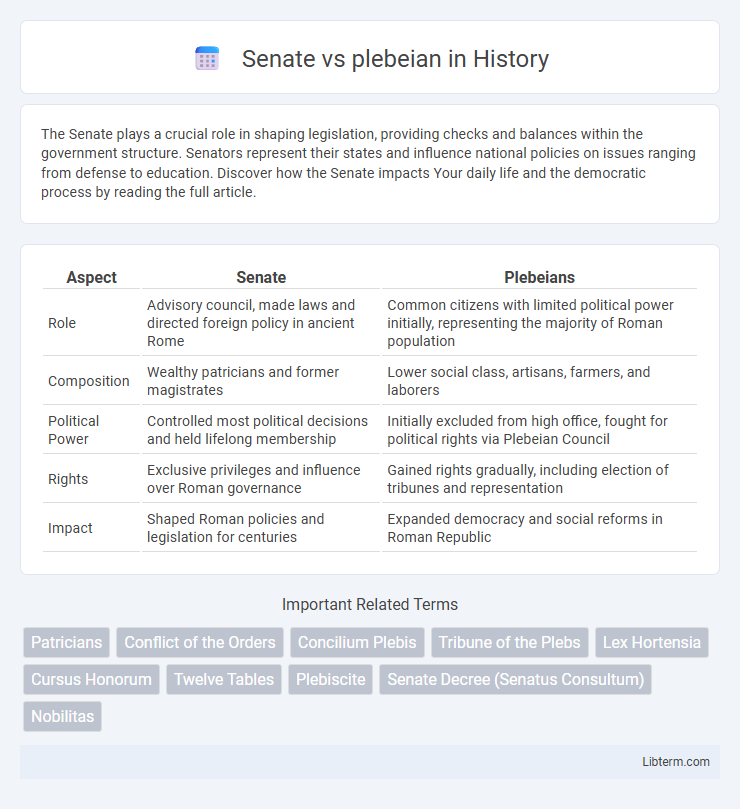The Senate plays a crucial role in shaping legislation, providing checks and balances within the government structure. Senators represent their states and influence national policies on issues ranging from defense to education. Discover how the Senate impacts Your daily life and the democratic process by reading the full article.
Table of Comparison
| Aspect | Senate | Plebeians |
|---|---|---|
| Role | Advisory council, made laws and directed foreign policy in ancient Rome | Common citizens with limited political power initially, representing the majority of Roman population |
| Composition | Wealthy patricians and former magistrates | Lower social class, artisans, farmers, and laborers |
| Political Power | Controlled most political decisions and held lifelong membership | Initially excluded from high office, fought for political rights via Plebeian Council |
| Rights | Exclusive privileges and influence over Roman governance | Gained rights gradually, including election of tribunes and representation |
| Impact | Shaped Roman policies and legislation for centuries | Expanded democracy and social reforms in Roman Republic |
Introduction: Understanding Senate and Plebeians
The Roman Senate functioned as the principal governing body composed mainly of patricians, wielding significant influence over legislation and state affairs. Plebeians represented the common people of Rome, initially excluded from political power and facing social inequalities. The ongoing tension between the Senate's aristocratic authority and plebeian demands for rights shaped the foundation of Roman Republic governance.
Historical Background: Rome’s Social Structure
The Roman Senate, composed primarily of patricians, represented the aristocratic ruling class, while plebeians were the common citizens excluded from early political power. This social division originated from the founding of Rome, where patricians controlled land, religious offices, and governance, creating a rigid hierarchy. Over time, plebeian demands led to political reforms like the creation of the Tribune of the Plebs, challenging Senate dominance and reshaping Rome's social and political landscape.
The Senate: Composition and Function
The Senate, a central institution in ancient Rome, was composed primarily of wealthy aristocrats and patricians who held lifelong membership, shaping policies and laws. It functioned as an advisory body to magistrates, controlled public finances, and directed foreign policy, exerting significant influence over Rome's governance. The Senate's authority often clashed with the plebeians' demands, highlighting power struggles between elite senators and the broader populace.
Plebeians: Identity and Social Role
Plebeians, the commoners of ancient Rome, formed the foundation of Roman society, comprising artisans, laborers, and small farmers. Their social role was pivotal in shaping Rome's political landscape, as they sought legal and political equality through persistent resistance against patrician dominance in the Senate. Over time, plebeians gained significant rights, including the establishment of the Tribune of the Plebs, which empowered them to protect their interests and influence legislation.
Political Power: Senate Authority vs Plebeian Rights
The Roman Senate held significant political power, controlling legislation, foreign policy, and financial decisions, while plebeians initially lacked formal political representation and rights. Over time, plebeian efforts led to the establishment of the Tribune of the Plebs, which provided veto power and the ability to propose laws, gradually balancing political influence. This struggle between Senate authority and plebeian rights shaped the Republic's legal and social structure, highlighting the evolving dynamics of power distribution in ancient Rome.
Conflict and Compromise: The Struggle of the Orders
The Conflict of the Orders was a prolonged power struggle between the patrician Senate and the plebeian class in ancient Rome, where plebeians sought political equality and representation. Key compromises, such as the establishment of the Tribunes of the Plebs and the passage of the Twelve Tables, gradually reduced patrician dominance and enhanced plebeian rights. This dynamic tension shaped the Roman Republic's political structure, balancing elite governance with broader social participation.
Key Reforms: From Patrician Rule to Plebeian Gains
The key reforms during the transition from patrician rule to plebeian gains included the establishment of the Tribune of the Plebs, which granted plebeians political representation and protection against patrician magistrates. The Twelve Tables codified Roman laws, reducing patrician legal dominance and ensuring greater transparency and fairness in legal proceedings. Additionally, the Lex Hortensia (287 BCE) made plebiscites binding for all citizens, effectively integrating plebeian decisions into the legislative framework of the Roman Republic.
Impact on Roman Governance
The Senate wielded significant influence over Roman governance by shaping legislation, controlling finances, and directing foreign policy, often representing aristocratic interests. Plebeian assemblies introduced a democratic element by enabling common citizens to propose and vote on laws, challenging patrician dominance and contributing to legal reforms such as the Twelve Tables. The tension and gradual integration between Senate authority and plebeian rights fostered a more balanced political structure, which helped stabilize and evolve the Roman Republic.
Legacy: Senate vs Plebeians in Modern Context
The legacy of the Roman Senate versus the plebeians profoundly shapes modern democratic principles, illustrating the evolution of political inclusion and representation. Senate structures inspire contemporary legislative bodies emphasizing aristocratic governance, while plebeian struggles highlight the importance of popular rights and social equity. This dynamic informs current debates on balancing elite authority with grassroots participation in political systems worldwide.
Conclusion: Ongoing Influence on Political Systems
The Senate's enduring influence shapes modern political systems by exemplifying representative governance and legislative authority, contrasting with the plebeian struggle that highlights the importance of social equity and popular participation. This dynamic balance between elite decision-making and grassroots advocacy informs contemporary debates on democratic inclusion and power distribution. The tension between senatorial control and plebeian rights continues to drive reforms in political institutions worldwide.
Senate Infographic

 libterm.com
libterm.com